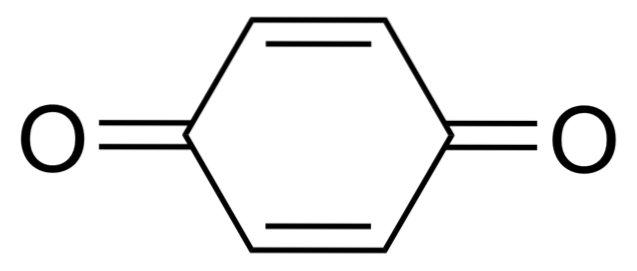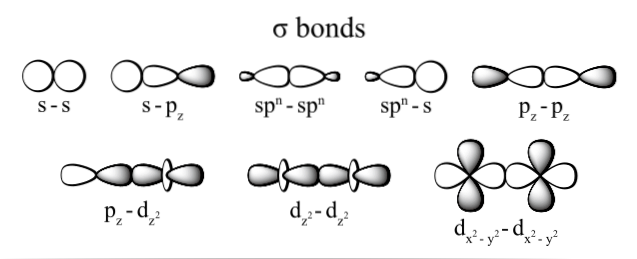
Quinones properties, classification, obtaining, reactions
The quinones they are organic compounds with an aromatic base such as benzene, naphthalene, anthracene and phenanthrene; however, they are considered conjugated diacetone cyclic molecules. They derive from the oxidation of phenols, and therefore, the C-OH groups are oxidized to C = O.
They are generally colored compounds that act as dyes and colorants. They also serve as the basis for the development of many medicines.

One of the derivatives of 1,4-benzoquinone (upper image) is a constituent of ubiquinone or coenzyme Q, present in all living beings; hence its name "ubiquitous".
This coenzyme is involved in the operation of the electronic transport chain. The process occurs in the inner mitochondrial membrane, and is coupled with oxidative phosphorylation, in which ATP is produced, the main energy source for living beings..
Quinones are found in nature in the form of pigments in plants and animals. They are also present in many herbs that are traditionally used in China, such as rhubarb, cassia, senna, comfrey, giant knuckle, polygonum, and aloe vera..
Quinones that use phenolic groups as auxochromes (hydroxy quinones), have a variety of colors such as yellow, orange, reddish brown, purple, etc..
Article index
- 1 Physical and chemical properties
- 1.1 Physical appearance
- 1.2 Smell
- 1.3 Boiling point
- 1.4 Melting point
- 1.5 Sublimation
- 1.6 Solubility
- 1.7 Solubility in water
- 1.8 Density
- 1.9 Vapor pressure
- 1.10 Autoignition
- 1.11 Heat of combustion
- 1.12 Odor (threshold)
- 2 Classification of quinones
- 2.1 Benzoquinones
- 2.2 Naphthoquinones
- 2.3 Anthraquinones
- 3 Obtaining
- 3.1 Benzoquinone
- 3.2 Naphthoquinone
- 3.3 Anthraquinone
- 4 Reactions
- 5 Functions and uses
- 5.1 Vitamin K1
- 5.2 Ubiquinone
- 5.3 Benzoquinones
- 5.4 Plastoquinone
- 5.5 Naphthoquinones
- 6 References
Physical and chemical properties
The physical and chemical properties of 1,4-benzoquinone are described below. However, given the structural similarity that exists between all quinones, these properties can be extrapolated to others knowing their structural differences..
Physical appearance
Yellowish crystalline solid.
Odor
Irritating spicy.
Boiling point
293 ºC.
Melting point
115.7 ° C (240.3 ° F). Therefore, quinones with higher molecular masses are solids with melting points higher than 115.7 ºC..
Sublimation
Can sublimate even at room temperature.
Solubility
Greater than 10% in ether and in ethanol.
Water solubility
11.1 mg / mL at 18 ° C. Quinones in general are very soluble in water and polar solvents due to their ability to accept hydrogen bonds (despite the hydrophobic component of their rings).
Density
3.7 (relative to air taken as 1)
Vapor pressure
0.1 mmHg at 77 ºC (25 ºC).
Autoignition
1040ºF (560ºC).
Heat of combustion
656.6 kcal / g. mole)
Odor (threshold)
0.4 m / m3.
Classification of quinones
There are three main groups of quinones: the benzoquinones (1,4-benzoquinone and 1,2-benzoquinone), the naphthoquinones, and the anthraquinones..
Benzoquinones
All of them have in common a benzene ring with C = O groups. Examples of benzoquinones are: embelin, rapanone, and primin.
Naphthoquinones
The structural base of naphthoquinones, as their name implies, is the naphthenic ring, that is, they are derived from naphthalene. Examples of naphthoquinones are: plumbagin, lawsona, juglone and lapachol.
Anthraquinones
Anthraquinones are characterized by having the anthracene ring as a structural base; that is, a set of three benzene rings linked by their sides. Examples of anthraquinones are: barbaloin, alizarin and chrysophanol.
Obtaining
Benzoquinone
-Benzoquinone can be obtained by oxidation of 1,4-dihydrobenzene with sodium chlorate, in the presence of divanadium pentoxide as a catalyst, and sulfuric acid as a solvent..
-Benzoquinone is also obtained by the oxidation of aniline with manganese dioxide or chromate, as oxidants in an acid solution..
-Benzoquinone is produced by the oxidation processes of hydroquinone, for example, in the reaction of benzoquinone with hydrogen peroxide.
Naphthoquinone
Naphthoquinone is synthesized by the oxidation of naphthalene by chromic oxide in the presence of alcohol.
Anthraquinone
-Anthraquinone is synthesized by the condensation of benzene with phthalic anhydride in the presence of AlCl3 (Friedel-Crafts acylation), generating O-benzoyl benzoic acid, which undergoes an acylation process forming anthraquinone.
-Anthraquinone is produced by oxidation of anthracene with chromic acid in 48% sulfuric acid, or by oxidation with air in the vapor phase.
Reactions
-Reducing agents, such as sulfuric acid, stannous chloride or hydroiodic acid, act on benzoquinone reducing it to hydroquinone.
-Also a solution of potassium iodide reduces a solution of benzoquinone to hydroquinone, which can be oxidized again with silver nitrate.
-Chlorine and chlorinating agents such as potassium chlorate, in the presence of hydrochloric acid, form chlorinated derivatives of benzoquinone.
-1,2-benzoquinone condenses with O-phenyldiamine to form quinoxalines.
-Benzoquinone is used as an oxidizing agent in organic chemistry reactions.
-In the Baily-Scholl synthesis (1905), anthraquinone condenses with glycerol to form bezanthrene. In the first step, the quinone is reduced by copper with sulfuric acid as the medium. A carbonyl group becomes a methylene group, and then glycerol is added.
Functions and uses
Vitamin K1
Vitamin K1 (phylloquinone), formed by the union of a derivative of naphthoquinone with a side chain of an aliphatic hydrocarbon, plays a central role in the coagulation process; since it intervenes in the synthesis of prothrombin, a coagulation factor.
Ubiquinone
Ubiquinone, or cytochrome Q, is formed by a derivative of pbenzoquinone attached to a side chain of an aliphatic hydrocarbon.
It is involved in the electronic transport chain under aerobic conditions, coupled with the synthesis of ATP in the mitochondria.
Benzoquinones
-Embelin is a dye used to dye wool yellow. In addition, alizarin (anthraquinone) is used in staining.
-An alkaline solution of 1,4-benzenediol (hydroquinone) and sodium sulfate is used as a developer system that acts on the activated silver bromide particles, reducing them to metallic silver, which constitutes a negative of the photos..
Plastoquinone
Plastoquinone is part of an electron transport chain between photosystems I and II, which are involved in photosynthesis in plants.
Naphthoquinones
-The protozoa of the genera Leishmania, Trypanosoma and Toxoplasma show susceptibility to a naphthoquinone present in sundew (D. lycoides).
-Plumbagin is a naphthoquinone that has been used to relieve rheumatic pain and also has antispasmodic, antibacterial and antifungal actions.
-An antitumor, antimalarial and antifungal activity has been reported in a naphthoquinone, called lapachol.
-2,3-Dichloro-1,4-naphthoquinone exhibits antifungal activity. It had previously been used in agriculture to control the pest and in the textile industry..
-The antibiotic fumaquinone has been synthesized that exhibits selective activity against gram positive bacteria, especially with Streptomyces fumanus.
-There are naphthoquinones that exert an inhibitory action on Plasmodium sp. Derivatives of naphthoquinone have been synthesized that have an antimalarial efficiency four times higher than quinine.
-Lawsona is a pigment isolated from the leaves and stem of henna. It has an orange coloration and is used in hair dyeing.
-Juglona, obtained from walnut leaves and shells, is used to stain wood.
References
- Graham Solomons T.W., Craig B. Fryhle. (2011). Organic Chemistry. Amines. (10th edition.). Wiley plus.
- Carey F. (2008). Organic Chemistry. (Sixth edition). Mc Graw Hill.
- Wikipedia. (2018). Quinone. Recovered from: en.wikipedia.org
- PubChem. (2018). Docebenone. Recovered from: pubchem.ncbi.nlm.nih.gov
- John D. Robert and Marjorie C. Caserio. (2018). Quinones. Chemistry LibreTexts. Recovered from: chem.libretexts.org
- López L., Lluvia Itzel, Leyva, Elisa, & García de la Cruz, Ramón Fernando. (2011). Naphthoquinones: more than natural pigments. Mexican journal of pharmaceutical sciences, 42(1), 6-17. Recovered from: scielo.org.mx



Yet No Comments